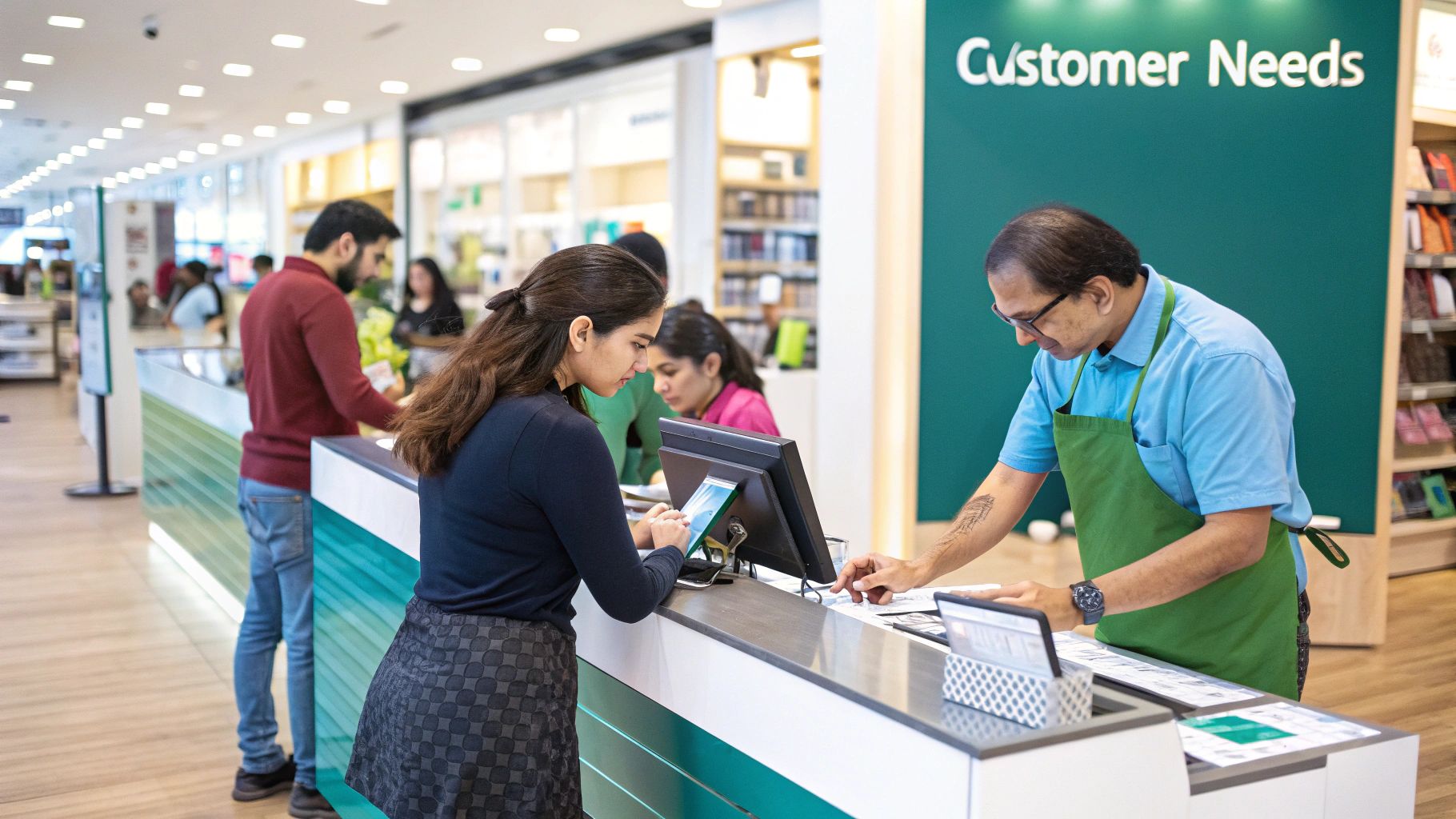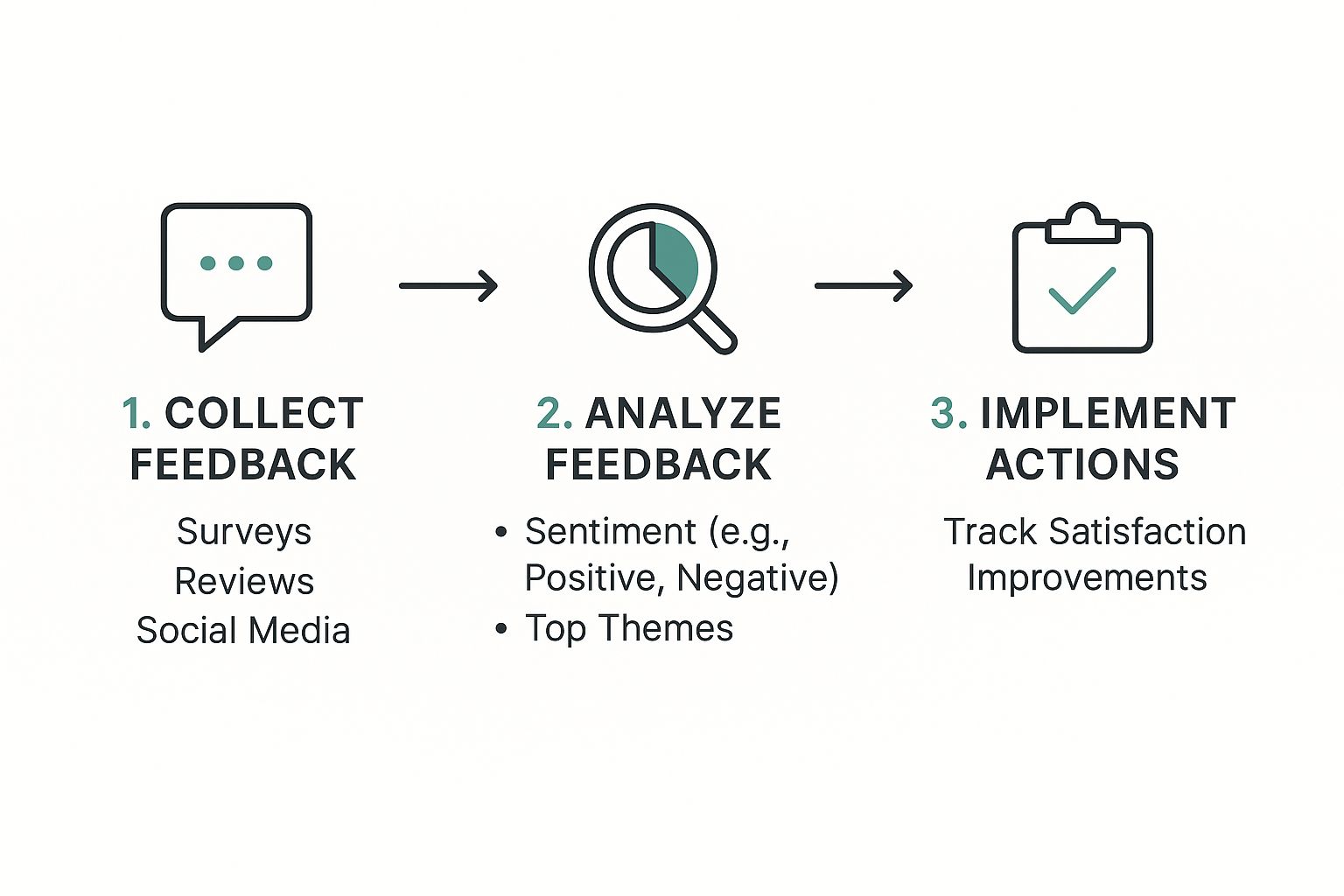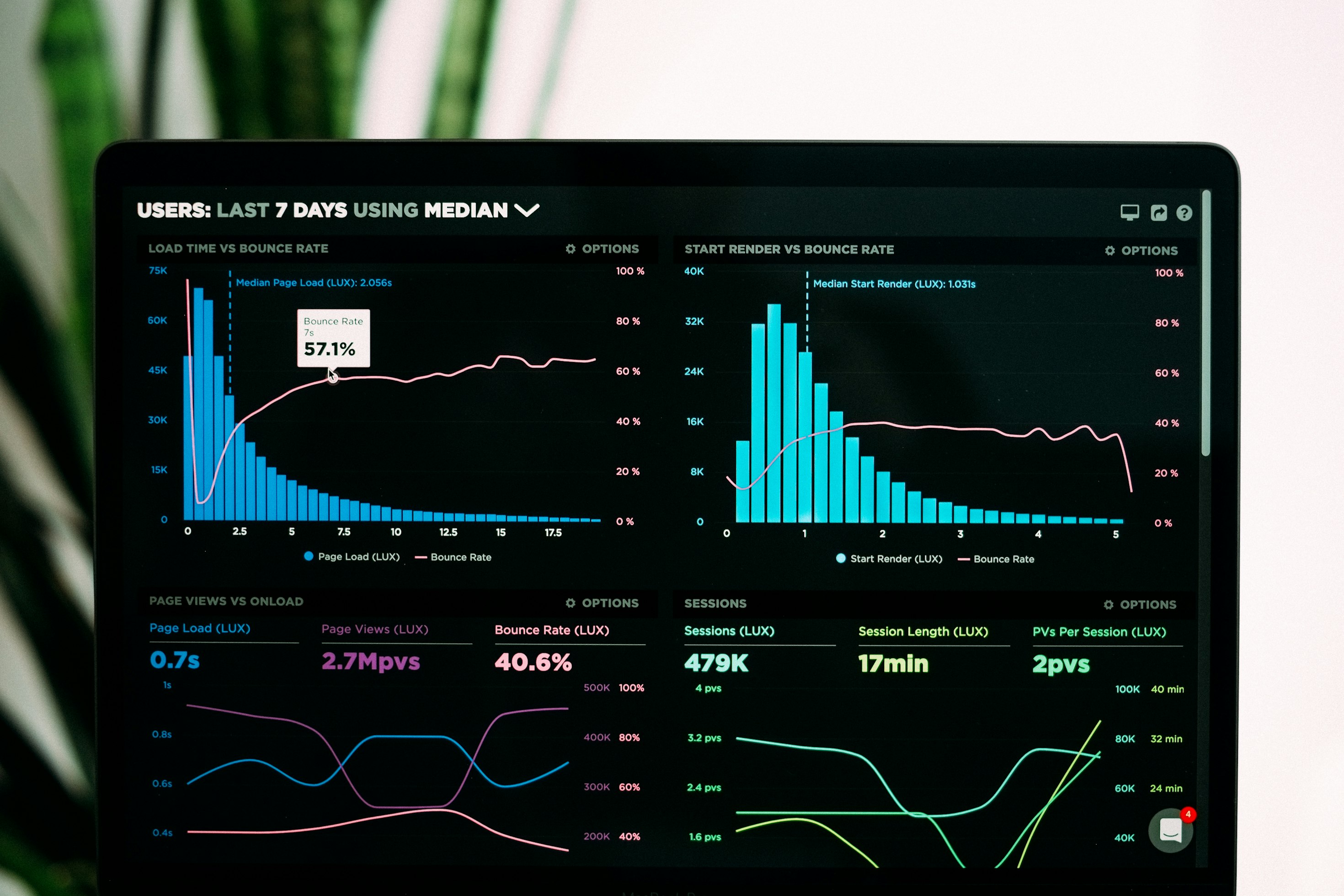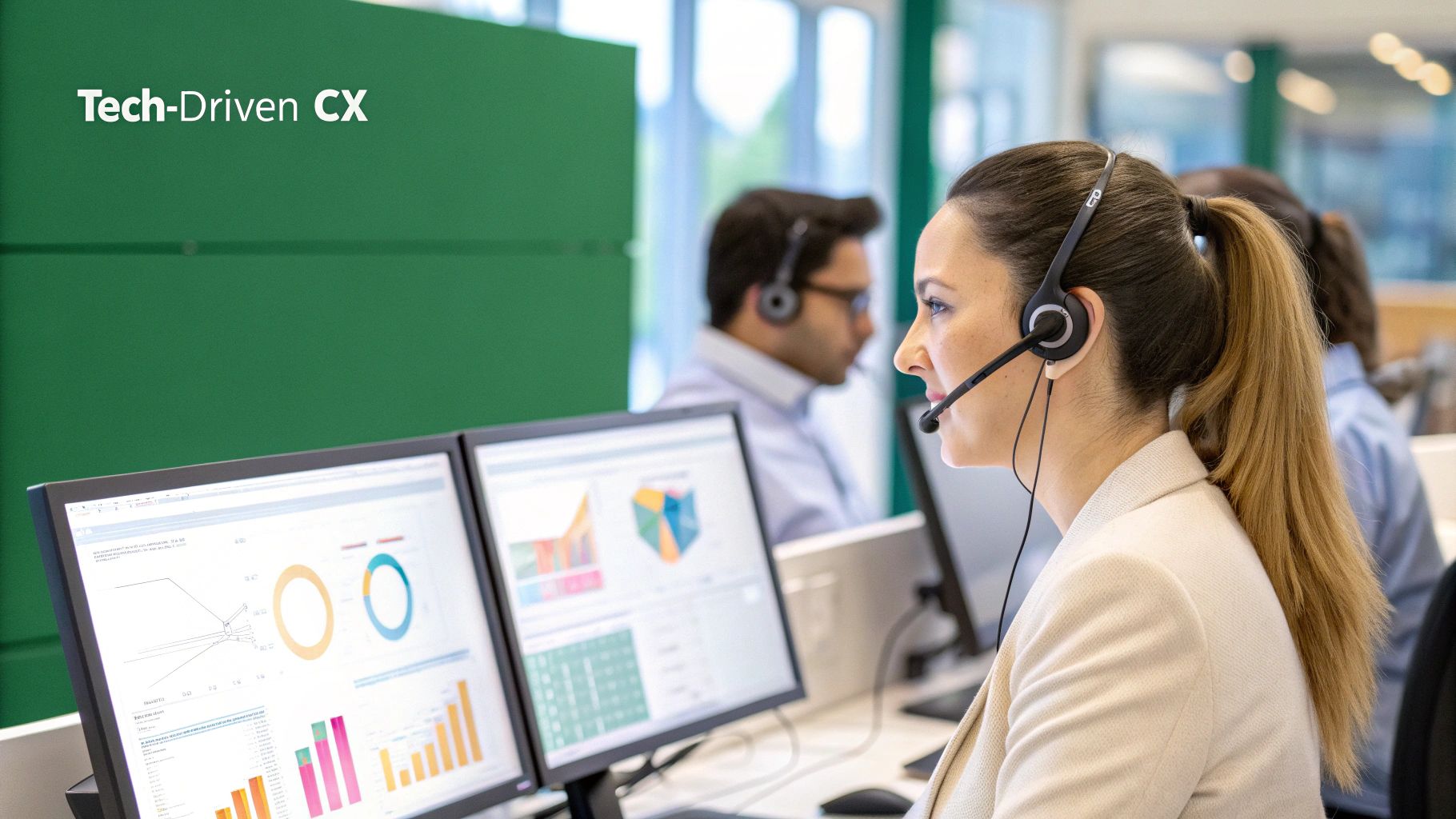Hey there! Thinking about how to improve customer experience? It's often the little things that make the biggest difference. You might be surprised to learn that one of your best tools for creating happy customers is probably something you already have: your guest WiFi.
Let's be honest, when most people think of WiFi, they think of a clunky password screen. But what if you could turn that everyday, functional touchpoint into a genuinely helpful and memorable interaction? Let's chat about how to do just that.
Your Guide to a Better Customer WiFi Experience
Ready to transform your venue’s WiFi from a basic utility into a powerful tool for customer engagement? This guide walks you through exactly how to improve the customer experience using your existing Cisco or Meraki network. I'll skip the heavy technical jargon and focus on friendly, actionable strategies you can use right away.
A smooth, secure, and personalized WiFi connection can become your secret weapon for building real loyalty. Modern Captive Portals, powered by platforms like Splash Access, do far more than just grant internet access—they create valuable, interactive moments that people remember.
This approach is already making a huge difference in all sorts of places:
- Education: Making life easier for IT admins and students by simplifying logins for thousands of devices using solutions like EasyPSK.
- Retail: Chatting directly with shoppers by pushing personalized promotions to them right on the WiFi login screen.
- Corporate: Effortlessly securing a BYOD (Bring Your Own Device) environment with smart Authentication Solutions like IPSK.
In every one of these sectors, the right login solution turns a basic amenity into a thoughtful experience that makes people feel welcome and encourages them to return.
The Big Shift Towards Experience-Driven Business
In today's world, it's not just about what you sell. A staggering 89% of businesses are expected to compete primarily on customer experience (CX) by 2025, making it the key brand differentiator. This change is fueled by what we all want as customers—in fact, 80% of people say they are more likely to buy from brands that deliver personalized interactions.
This isn't just a passing trend; it's a fundamental change in how business gets done. A positive experience has become a core part of the product itself.
Think about it: your WiFi login page is often the very first digital "hello" a customer gets from you inside your physical space. A well-designed page can create a welcoming and professional first impression, just like this:
The key takeaway here is simple: that login process is your first real chance to engage directly with people in your venue. Let's make it count!
A friendly WiFi experience is built on several core components that work together. I've broken down the most important ones in this table to show how they impact the customer and where they matter most.
Core Components of a Modern WiFi Customer Experience
| Component | Impact on Customer Experience | Key Sector |
|---|---|---|
| Seamless Onboarding | Gets rid of frustrating logins with one-click or social options, making access fast and effortless. | Retail, Hospitality |
| Branded Portal | Shows off your brand and creates a professional, trustworthy first impression. | Corporate, Education |
| Personalized Content | Delivers targeted ads, friendly surveys, or welcome messages based on who the user is. | Retail, Venues |
| Robust Security | Builds trust by making sure everyone's data is protected with secure Authentication Solutions. | All Sectors |
These elements are the building blocks of a system that feels helpful, not just functional. By focusing on them, you turn a simple connection into a positive brand interaction.
Connecting WiFi to Broader CX Goals
Improving your WiFi experience is a critical piece of a much larger customer experience puzzle. The principles of creating a smooth, personalized digital "welcome mat" can be applied across all of your customer interactions.
For those in hospitality or other service-based industries, this is just the beginning. Think beyond WiFi and explore other proven strategies to improve guest satisfaction and enhance the entire customer journey. The ultimate goal is to make every single touchpoint feel valuable and effortless, whether it happens online or in person.
Creating a Personalized Connection for Every User
The days of a one-size-fits-all WiFi login are long gone. People today—whether they're browsing in a mall, studying on campus, or working in the office—expect an experience that feels like it was designed specifically for them. This is where your WiFi Captive Portal stops being a simple login gate and becomes one of your most effective tools for building a real connection.
Think about it from the user's perspective. A shopper connects to your store's WiFi and is greeted with a coupon for a brand they actually like. A student logs into the campus network and sees a quick reminder about an event in their specific department. In an office with a BYOD policy, this means automatically assigning different network access levels based on an employee's role, all from a single, seamless login.
This isn't some far-off tech fantasy. It's happening right now by combining smart Authentication Solutions with the Cisco or Meraki hardware you already have. That initial login process becomes your first, and arguably best, opportunity to show users you get them.
Building Personalized Journeys by Sector
What makes a modern captive portal so powerful is its adaptability. You can fine-tune the experience for your specific environment, transforming a generic connection into a genuinely helpful interaction that significantly improves the overall customer experience.
Let's break down how this looks in the real world:
- Retail: A shopper uses their social media profile to connect. Your system can then use that basic demographic info to display a welcome screen with promotions for products they're likely to be interested in. Once they're connected, you could redirect them straight to your "new arrivals" page or the latest digital catalog.
- Education: A student signs in with their university ID. The Captive Portal can be set up to display their class schedule, current library hours, or alerts for campus activities. For IT departments managing thousands of devices, solutions like EasyPSK make this kind of secure, large-scale deployment surprisingly straightforward.
- Corporate: An employee connects their personal laptop to the office network. Using a secure method like IPSK (Identity Pre-Shared Key) on your Cisco Meraki infrastructure, they are instantly granted access only to the resources their job requires. This keeps the network secure while making life easier for your team.
The real goal here is to make every login feel less like a hurdle and more like a handshake. By using the data from the login itself, you can create a customized journey that feels both intuitive and valuable.
Using Login Data to Drive Customization
So, how does this all work behind the scenes? The magic happens when you use the information gathered during authentication to shape what the user sees next. This isn't about being creepy or invasive; it's purely about being relevant and helpful.
When someone logs in, you can capture basic, non-intrusive data points—maybe from a social login, a simple form, or the authentication method itself. This data then triggers predefined rules within your captive portal system.
Here are a few practical examples:
- Custom Splash Pages: You can show a completely different welcome screen to a first-time visitor compared to a loyal, returning customer.
- Targeted Advertisements: Display ads based on a user's physical location within a large venue, like a specific terminal in an airport or a particular wing of a shopping center.
- Smart Redirects: After a successful login, send people to the page that's most useful for them in that moment. A conference attendee could land on the event schedule, while a hotel guest is sent to a page for ordering room service.
This attention to detail is what elevates a standard WiFi offering into a thoughtful, customer-centric experience. It proves you've considered the user's context and are actively working to make their visit better. For more great ideas, check out these proven customer engagement best practices that build on these concepts.
By turning a simple connection into a memorable and helpful interaction, you directly boost satisfaction and show that you value every single person who walks through your doors.
Streamlining Logins for Education, Retail, and Corporate
A clunky, complicated login is the fastest way to ruin a first impression. We've all been there—fumbling with passwords just to get online. The reality is that in different environments like schools, stores, and offices, the needs for access and security vary wildly.
The secret to a great experience is making authentication feel both simple and safe, no matter the setting. When you get this right, you remove the first and most common point of friction for your visitors. They get what they need—fast, secure internet—and you get a happy, engaged user right from the start.
Making Connections Seamless in Education
Let's start with Education. The sheer scale of devices on a campus can be a nightmare for IT teams. Every single day, thousands of students and staff try to connect laptops, tablets, and phones to the network. Trust me, a single, shared password just doesn't cut it for security or sanity.
This is where specific Authentication Solutions like EasyPSK become a game-changer. Instead of one password that gets passed around (and inevitably compromised), EasyPSK lets an institution generate a unique key for each student or device. This key can last for an entire semester or academic year, which dramatically cuts down on those dreaded "I forgot the WiFi password" support tickets.
- For Students: The login process becomes a one-and-done deal. They connect once at the start of the term and stay connected.
- For IT Admins: It’s a secure, scalable way to manage thousands of connections on their Cisco or Meraki network infrastructure without the daily chaos.
By simplifying this one crucial step, universities create a much more positive and productive environment for everyone on campus.
This shows how improving the user experience is a continuous cycle. It all starts with listening and ends with meaningful action.
Speed and Simplicity in Retail
In Retail, the game is completely different. Shoppers want to get online instantly, often just to check a price, look up a review, or post a find on social media. Any delay or complicated form is a barrier you just don't want.
Here, Captive Portals shine by offering ultra-simple login options. Think one-click social media logins or just a quick acceptance of the terms and conditions. Speed is the priority. A shopper can connect in seconds, see a branded welcome page with a daily deal, and get right back to their shopping. It’s a quick, valuable touchpoint that adds to their in-store experience.
For a deeper look at the technical side, you can explore how to set up guest WiFi that puts this kind of speed first.
Securing the Corporate BYOD Environment
Now, let's talk about corporate offices. With Bring-Your-Own-Device (BYOD) policies being the norm, security jumps to the top of the priority list. You have employees, contractors, and guests all connecting personal devices to the network, and you absolutely must ensure sensitive company data stays protected.
This is where Identity Pre-Shared Keys (IPSK) become essential. Operating on a Cisco Meraki network, IPSK assigns a unique, individual password to every single user or device.
This approach gives you the best of both worlds:
- For Users: The login feels familiar and simple—they just enter their unique passphrase.
- For the Business: Security is massively boosted. If an employee leaves, their individual key is simply revoked with zero impact on anyone else. There's no need to change a company-wide password and deal with the inevitable confusion.
This granular control is exactly what's needed to maintain a secure yet user-friendly network in a modern corporate setting. By matching the authentication method to the specific needs of the environment, you can perfect the balance between ease of use and robust security, ensuring everyone has a smooth and safe onboarding experience.
Turn Your Wi-Fi Analytics Into Smarter Business Decisions
Think of your guest Wi-Fi network. Most businesses see it as a simple utility—a connection for customers. But what if I told you it's a hidden goldmine of data, just waiting to be tapped? The real magic happens when you move beyond just counting connections and start understanding the stories your network data is telling you about your physical space.
By integrating a platform like Splash Access directly with your Cisco Meraki dashboard, you unlock a completely new layer of insight. Suddenly, you're not just seeing how many people logged on today; you're seeing real, tangible customer behaviors unfold right before your eyes.
From Raw Numbers to Real-World Strategy
Let's be honest, raw data is pretty useless on its own. What does a "high dwell time" actually mean for your bottom line? What should you do when you see a traffic spike at 2 PM? This is where the expertise comes in—connecting those abstract numbers to the reality of your day-to-day operations.
Here are a few of the key metrics I always tell clients to watch, and what they really mean:
- Foot Traffic Patterns: Are people bee-lining for one area and completely ignoring another? This shows you the natural flow of your space.
- Peak Hours: Don't just look at busy days. Pinpoint the exact hours your venue hits maximum capacity so you can staff accordingly.
- Dwell Times: See how long people linger in specific zones. This is your best indicator of what’s grabbing their attention (or what’s failing to).
- Return Visitor Rate: How many people are coming back? This simple metric is a powerful gauge of customer loyalty.
This isn't just trivia; it's a blueprint for making smarter, more effective decisions. For a deeper dive, our guide on advanced Wi-Fi analytics can help you turn these metrics into full-blown strategies.
Analytics in Action: Real Scenarios for Different Venues
The beauty of this data is how it adapts to different goals. A university campus, a retail shop, and a corporate office all have unique needs, but analytics can sharpen decision-making for each one.
In a Retail Store: Imagine you see high dwell times in front of a new electronics display. That's a huge green light. You can immediately train staff to be experts on that product or place high-margin accessories right next to it. On the flip side, if an entire aisle is a ghost town, you know it's time to rethink the layout or add signage that pulls people in.
On a University Campus: Analytics help administrators manage campus resources way more effectively. If the data shows a library wing is always empty while another is packed, that's your cue. You can reallocate furniture, add more power outlets, or change study zone designations—all without a costly renovation. It’s about improving the student experience with the resources you already have.
In a BYOD Corporate Office: This kind of insight is a game-changer for facility planning. Maybe your data shows that small huddle rooms are booked solid from 9 to 5 while the big boardrooms are mostly empty. That’s invaluable information for your next office redesign, ensuring you build a space that reflects how your teams actually work.
The goal here is simple: stop guessing and start knowing. When you have the right analytics from your Captive Portals and Authentication Solutions, you can finally make evidence-based decisions that create a better experience for everyone.
The market is already shifting in this direction. Real-time data and predictive analytics are no longer a "nice-to-have." In fact, industry reports, like these customer experience trends from Lucidworks, show that by 2025, an estimated 90% of businesses will rely on unified data platforms to deliver seamless digital experiences. This move toward instant, frictionless service is exactly what separates a good experience from a truly great one.
The Real ROI of a Superior WiFi Experience
Investing in a better customer experience always feels like the right thing to do, but let's be honest—it has to make business sense. This is where we connect the dots between a fantastic WiFi experience and what really matters to your bottom line: growth, loyalty, and revenue. It's time to stop seeing WiFi as just another cost and start treating it as a powerful engine for your business.
The journey starts the moment a user tries to connect. That initial interaction, your Captive Portal, is so much more than a gateway to the internet; it's your first, and sometimes only, chance to make a good impression. A clunky, slow, or insecure login can sour the experience instantly. A seamless one, on the other hand, builds immediate trust.
From First Impressions to Tangible Returns
Think about the direct revenue opportunities. A well-designed captive portal, especially when running on a robust Cisco or Meraki network, can do more than just grant access. You can use it to gather valuable marketing opt-ins, display targeted ads for in-house promotions, or even offer premium, high-speed access for a small fee. These are immediate, measurable returns.
But the real magic happens over the long term. A consistently great experience fosters loyalty in a way that one-off discounts never could. When customers feel their needs are met effortlessly, they don't just come back—they spend more and become vocal advocates for your brand.
The numbers back this up. An incredible 84% of companies that focused on improving their CX reported an increase in revenue. On top of that, 95% saw a boost in customer loyalty. These aren't minor shifts. With 64% of consumers now saying CX is more important than price, it’s clear where businesses need to put their energy. For more on this, check out the latest customer experience trends on Custify.com.
Calculating the Value Across Different Sectors
The return on investment (ROI) will look a little different depending on your industry, but the core principle holds true: a better experience leads to better outcomes.
Let’s look at how this plays out in the real world:
- Retail: A shopper who connects easily is more likely to stay in the store longer, browse more aisles, and actually act on a personalized offer delivered through the portal. The ROI here is measured in bigger basket sizes and more frequent visits.
- Education: A campus that rolls out EasyPSK for simple, secure access sees a dramatic drop in IT support tickets. This frees up staff for more critical tasks, and the ROI comes from pure operational efficiency and better student satisfaction scores.
- Corporate BYOD: Using secure Authentication Solutions like IPSK prevents costly data breaches and simplifies network management in a Bring-Your-Own-Device world. In this case, ROI is all about mitigating risk and cutting down administrative headaches.
The real return isn't just about the money you make today. It's about reducing customer churn, increasing lifetime value, and building a reputation that attracts new business without you having to lift a finger.
The Long-Term Payoff of Loyalty
Let’s face it, customer churn is expensive. Acquiring a new customer can cost five times more than keeping an existing one. A superior WiFi experience, built on reliable Cisco Meraki hardware and managed through an intelligent Captive Portal, is one of the most effective retention tools you have.
When a guest at a hotel has a flawless connection for both their work video calls and streaming movies, they’re far more likely to rebook and leave a glowing review. You can see more on how this works in our guide to hotel WiFi solutions.
This same principle applies everywhere. It's the student choosing to study in the campus library because the connection is dependable. It's the shopper returning to a store where they feel valued and understood.
This loyalty creates a powerful positive feedback loop. Happy customers spend more, they tell their friends about you, and they provide the invaluable social proof that builds a rock-solid brand. Investing in an exceptional WiFi experience isn't just an IT expense; it's one of the smartest, highest-return investments you can make in your business's future.
Common Questions About WiFi Experience
Still have a few questions about how your WiFi network can actually elevate your business? You're not alone. It's easy to get lost in the technical jargon when you're talking about network access. Let's clear the air and tackle some of the most common queries I hear about Captive Portals and modern Authentication Solutions for Cisco and Meraki networks.
My goal here is to show you how these tools can practically help you improve the customer experience, whether you're running a busy Retail shop, a sprawling university campus in the Education sector, or a secure Corporate office.
How Does a Captive Portal Really Improve Retail CX?
A captive portal takes a standard WiFi login and turns it into a powerful marketing and engagement opportunity. Instead of that boring, generic password box, you can greet shoppers with a beautifully branded page that immediately shows off new arrivals, daily deals, or upcoming in-store events. It’s a much warmer welcome.
The real win for the customer experience, though, is how easy it makes getting online. By offering simple one-click logins through social media or a quick email entry, you get shoppers connected in seconds. In return for the free WiFi, you can capture valuable, permission-based marketing opt-ins. Once they're connected, you can even redirect them to your e-commerce site or a quick feedback survey, bridging your physical and digital storefronts seamlessly.
What is IPSK and Why Is It Essential for BYOD?
IPSK, or Identity Pre-Shared Key, is a game-changer for businesses that have a 'Bring Your Own Device' (BYOD) policy, especially those running on networks like Cisco Meraki. For a long time, the only option was a single shared password for everyone—a method that is, frankly, a security nightmare. If one person left, you had to change the password for everyone.
IPSK flips that model on its head by generating a unique, private passphrase for each individual user or device on your network.
This means if an employee leaves the company, you simply revoke their specific key. Nobody else is affected. This one change massively boosts your security and simplifies network management for the IT team, all while users get the simple, familiar login process they already know.
This balance of rock-solid security and user convenience is crucial. You can see how this fits into a bigger security strategy by reading about network security for small businesses, which breaks down the essential layers of protection.
Can These Solutions Handle a Large University Campus?
Absolutely. This is exactly the kind of environment where platforms like Splash Access really shine. They are built from the ground up to handle the massive scale of large Education institutions. IT administrators are tasked with the monumental job of onboarding thousands of student and faculty devices each semester, and that's where a feature like EasyPSK becomes a lifesaver.
With EasyPSK, admins can programmatically generate unique keys for every single user that can last an entire academic year. This all but eliminates the endless stream of IT support tickets for basic WiFi connection problems. Beyond just access, the Captive Portal becomes a vital campus communication hub—perfect for posting announcements, event schedules, or even emergency alerts that every single person sees when they connect.
Is Setting Up a Personalized Portal on Cisco Meraki Difficult?
This is probably the best part: it’s surprisingly simple. Modern platforms like Splash Access are designed to integrate directly with the Cisco Meraki dashboard through APIs. What this means for you is that you don't need to be a developer or know how to code to create a truly sophisticated user experience.
You can use pre-built templates and intuitive drag-and-drop editors to design your login pages, set up different access methods, and map out the entire user journey. The whole process is managed from a straightforward web interface, letting you roll out and update advanced portals across one or hundreds of locations without bogging down your IT department.
Ready to turn your WiFi from a simple utility into a powerful tool for engagement? Splash Access makes it happen. Discover how our intuitive captive portals for Cisco Meraki can help you create a personalized, secure, and memorable experience for every visitor. Start building better connections today at https://www.splashaccess.com.









